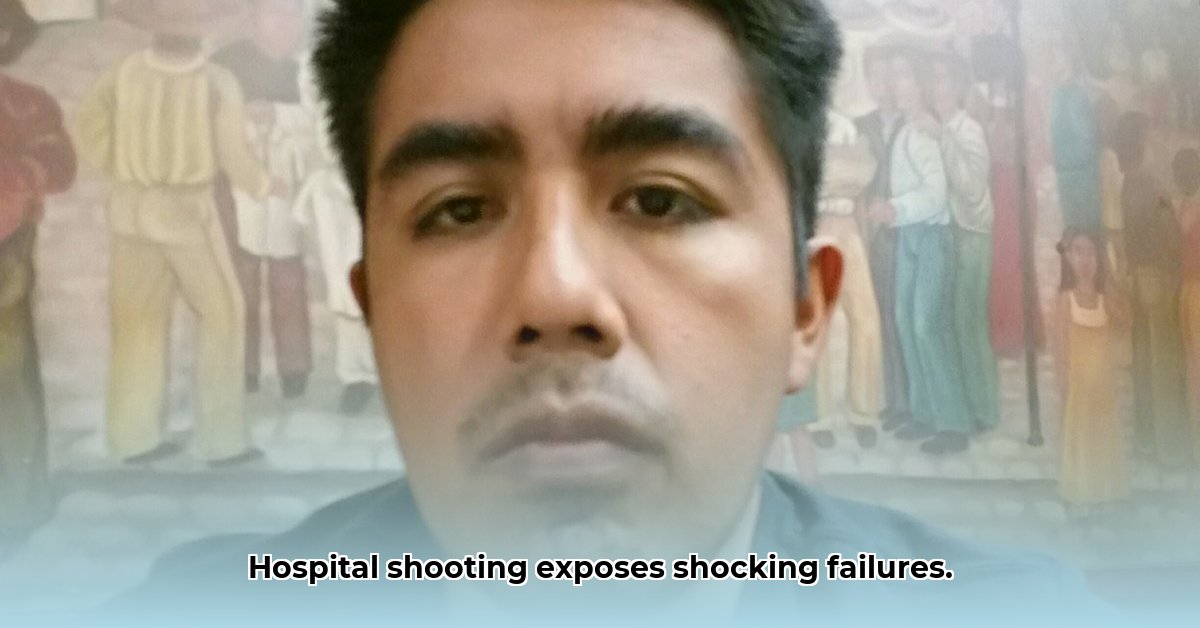Archangel Ortiz: A Wake-Up Call for Systemic Change – Hospital Security, Mental Health Crisis
The shooting at UPMC Memorial Hospital in February 2025, committed by Archangel Ortiz, left a community reeling and served as a critical incident for systemic change. It forced a confrontation with uncomfortable truths about grief, mental health, and the security of healthcare institutions, shining a spotlight on healthcare violence prevention. Let’s delve deeper into the factors that contributed to this tragedy and its implications for healthcare safety.
The Human Side: Understanding Archangel Ortiz – Grief, Mental Illness, and System Failure
Archangel Ortiz’s actions were horrific, but understanding his motivations requires more than just looking at the immediate event. Reports consistently point to a recent, devastating loss – the death of a loved one in the hospital’s intensive care unit. This profound grief, coupled with pre-existing mental health challenges, likely created a pressure cooker environment. His past legal troubles, including charges of harassment and domestic violence, add further layers of complexity. Court records also indicate previous charges such as driving with a suspended license.
A physician assistant at UPMC Memorial, Lester Mendoza, shared on Facebook that he interacted with Archangel-Ortiz for several days prior to the shooting, including when he delivered the news of his loved one’s passing. Mendoza described Ortiz as “broken” by the news.
The key question isn’t simply whether Mr. Ortiz was mentally ill, but rather, how did the systems fail to provide him with the timely, comprehensive support he may have needed? Could his struggles have been identified and addressed before the unthinkable occurred? This isn’t about assigning blame; it’s about acknowledging areas where we fell short and learning from this heartbreaking event to prevent future tragedies. Were there warning signs missed? Could earlier intervention have changed the course of events? These are critical questions that require thorough investigation.
Systemic Weaknesses: Gaps in Security and Support – Security Vulnerabilities, Emergency Response, Mental Healthcare Crisis
The hospital shooting wasn’t just a case of individual failings. It laid bare significant vulnerabilities in our systems including emergency preparedness. Were security measures at the hospital adequate to deter or respond to such a violent act? Did emergency response teams have the training and resources to handle the crisis effectively? The answers point to serious shortcomings and healthcare disparities.
- Security Gaps: The incident highlighted critical needs for improved access control, more frequent active shooter drills, and better training for hospital staff on identifying and responding to potentially volatile situations.
- Emergency Response Shortcomings: The response of law enforcement requires careful scrutiny. Could response times have been faster? Were the tactics used the most effective given the circumstances?
- The Mental Healthcare Crisis: The lack of readily available and accessible mental health support for individuals in crisis is a problem that the incident starkly highlighted.
A Path Forward: Actionable Steps for Prevention – Healthcare Security, Violence Prevention
Preventing future tragedies demands a multi-pronged approach. It’s not about finger-pointing; it’s about strengthening our systems across the board. The following steps are vital for hospitals, law enforcement, mental health services, and policymakers:
| Stakeholder | Short-Term Actions | Long-Term Strategies |
|---|---|---|
| Hospitals: | Enhance security protocols, conduct regular active shooter drills, provide comprehensive staff training on crisis management, invest in security technology, improve access control. | Implement robust mental health programs for staff and patients, including early intervention and readily available support services, conduct regular security audits and risk assessments, develop clear communication protocols for emergencies, foster partnerships with law enforcement. |
| Law Enforcement: | Update active shooter response protocols, improve inter-agency communication and collaboration with hospitals, provide specialized training for officers on de-escalation techniques and handling individuals in mental health crises. | Develop collaborative partnerships with mental health agencies, increase the accessibility of mental health support to law enforcement personnel, provide training to law enforcement on mental health awareness, establish clear communication channels with hospitals during emergencies. |
| Mental Health Services: | Expand access to crisis intervention services, increase the availability of mental healthcare professionals, improve affordability and accessibility of mental healthcare services for all. | Fund research on effective mental health interventions and early warning signs of potential violence, expand outreach programs, advocate for policy changes to remove barriers to mental health care, implement community-based mental health initiatives. |
| Policy Makers: | Review and strengthen regulations related to healthcare security and domestic violence prevention. | Allocate sufficient funding for mental health services, eliminate systemic inequalities in access to care, support research aimed at identifying and preventing violent behavior, enact legislation to improve access to mental healthcare, address social determinants of mental health. |
The shooting involving Archangel Ortiz is more than a news headline. It’s a catalyst for crucial conversations on hospital security and active shooter response. It underscores the complex interplay of individual struggles, systemic failures, and the need for comprehensive reform. By acknowledging the human element, addressing systemic weaknesses, and implementing substantial policy changes, we can work towards a future where such tragedies are less likely. This requires sustained commitment from all stakeholders — hospitals, law enforcement, mental health professionals, and policymakers alike. The lives lost demand nothing less.
How to Improve Hospital Security Protocols After a Mass Shooting – Access Control, Active Shooter Drills, Emergency Preparedness
Key Takeaways:
- The Archangel Ortiz hospital shooting exposed critical vulnerabilities in healthcare security, requiring upgrades for patient safety.
- A multi-pronged approach is needed, encompassing technology, policy, and training.
- Consistent, mandatory safety standards are urgently required nationwide, including mental health awareness programs.
- Collaboration between hospitals, government, unions, and law enforcement is vital for community safety.
The Aftermath of the Tragedy- Systemic Failure, Security Gaps
The Archangel Ortiz shooting at UPMC Memorial Hospital sent shockwaves through the healthcare community. The event highlighted a systemic failure in hospital security—a failure that demands immediate and comprehensive reform.
Identifying Systemic Weaknesses – Vulnerability Assessment, Staff Training, Communication Protocols
The shooting exposed significant gaps, including facility security. Were there inadequate security measures in place? Was there a lack of sufficient training for staff on active shooter response? Did communication protocols fail during the crisis? These aren’t just questions; they’re calls for action. We need to examine every aspect, from physical security to staff preparedness, to understand and prevent future incidents.
How to Improve Hospital Security Protocols After a Mass Shooting: A Multifaceted Approach – Surveillance Systems, De-Escalation Techniques, Policy Changes
The challenge isn’t simply about adding more security guards. It’s about creating a holistic system, addressing multiple layers of vulnerability, including access control systems. Here’s a strategic framework:
1. Enhancing Physical Security:
- Invest in advanced technology: This includes installing metal detectors, improving surveillance systems (including AI-powered analytics for threat detection), and implementing duress alarms for staff.
- Strengthen access control: Hospitals need robust systems to manage visitor access, ensuring only authorized personnel enter restricted areas.
- Improve building design: Consider architectural modifications and security design features that can minimize vulnerabilities.
2. Improving Staff Training and Preparedness:
- Active shooter drills: Regular, realistic drills are crucial.
- De-escalation training: Equipping staff with de-escalation techniques can prevent many incidents before they escalate into violence.
- Mental health support: Healthcare workers, often facing significant stress, need robust mental health resources.
3. Fostering Collaboration and Communication:
- Enhanced inter-agency coordination: Hospitals must collaborate closely with law enforcement and emergency responders.
- Clear communication protocols: Establish clear, concise communication protocols during emergencies to ensure efficient information flow.
- Strengthening partnerships: Hospitals should actively foster partnerships with local law enforcement, community organizations, and mental health providers.
4. Policy and Legal Considerations:
- Advocate for stricter legislation: We need strong, consistent safety standards across the nation.
- Review and update policies: Hospitals should regularly review and update their security protocols.
- Address staffing shortages: Staffing levels significantly impact patient care and safety.
Conclusion: A Call to Action – Hospital Safety, Healthcare Workers, Future Security
The Archangel Ortiz shooting was a tragedy that should never be repeated. By implementing these comprehensive security upgrades, we can create safer hospitals, protect healthcare workers, and ensure a more secure future for all. The time for action is now, before another tragedy strikes.
Proven Tactics for Preventing Hospital Violence- A Step-By-Step Guide – Risk Assessment, Safety Protocols, Staff Training
The Archangel Ortiz shooting exposed flaws in hospital security and highlighted workplace violence issues. It wasn’t just a single incident; it was a symptom of systemic issues. How can we prevent similar tragedies and address healthcare safety standards? The answer lies in a multi-pronged approach and violence prevention programs.
Understanding the Scope of the Problem – High-Pressure Environment, Potential for Conflict, Systemic Issues
Hospital violence affects staff, patients, and visitors alike. Stressed patients, emotionally charged family members, and overworked staff all interact in a high-pressure environment. The potential for conflict is significant. This isn’t about blaming individuals; it’s about fixing the system.
Proven Tactics for Preventing Hospital Violence- A Step-By-Step Guide
- Wind Power Energy Advantages: Clean, Domestic And Cost-Effective Power - November 12, 2025
- Wind Turbine Pieces: Examining The Industrys Future Growth - November 9, 2025
- Wind Turbine Installation: Building the Future of Energy - November 7, 2025
















